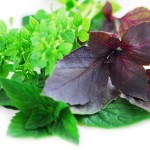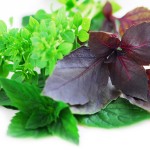 Herbs have long been used to add flavor to dishes, but research is starting to show that their benefits reach further than our taste buds.
Herbs have long been used to add flavor to dishes, but research is starting to show that their benefits reach further than our taste buds.
These flavor-boosters are packed with antioxidants and phytonutrients, which may help to protect our bodies against inflammation, infection, cancer, and other chronic diseases. Intrigued? Then read on! Your taste buds (and body) will thank you.
Herb Spotlight: 5 to Try
Rosemary
- Food pairings: Meat, poultry, beans, potatoes, mushrooms, apples
- Complimentary flavors: Parsley, thyme, oregano, marjoram, fennel, bay leaf
Bonus: Research suggests that marinating meats with rosemary before grilling may reduce the creation of carcinogenic compounds
Oregano
- Food pairings: Cheese, vegetables, tomato sauce
- Complimentary flavors: Garlic, parsley, thyme, basil, tarragon, marjoram
Bonus: Oregano has been shown to have the highest antioxidant activity among 27 culinary herbs
Thyme
- Food pairings: Seafood, poultry, lamb, tomatoes, mushrooms, artichokes
- Complimentary flavors: Sage, basil, bay leaf, oregano, parsley, rosemary
Bonus: Thyme contains a variety of health-promoting antioxidants
Sage
- Food pairings: Poultry, sausage, pork, rice, apples
- Complimentary flavors: Thyme, paprika, garlic, savory, parsley, ginger, marjoram
Bonus: Sage tea has been used reduce intestinal gas and promote digestion
Mint
- Food pairings: Beans, lamb, cucumber, peas, grains, fruits, beverages
- Complimentary flavors: Basil, oregano, citrus, cayenne, dill, thyme, parsley
Bonus: Peppermint has antioxidant, antitumor, antimicrobial, and antiviral activities
Get the Most Flavor From your Herbs:
- For dishes that have a long cook time, add herbs near the end. This will ensure that their flavors aren’t cooked out and lost.
- For cold dishes, add the herbs several hours before serving. This will allow for the flavors to blend – which takes longer in the absence of heat.
- Finely chop fresh herbs. This will allow for more flavor and aroma to be released.
Now, it’s Thyme to Experiment!
- Skip the salt! Season dishes with dried herbs and spices instead
- Sprinkle fresh/dried herbs into salads (fruit- or vegetable-based)
- Make your own marinade or salad dressing
- Give breads, muffins, and biscuits a savory twist by incorporating herbs
- Mix herbs into plain, fat-free Greek yogurt to make a flavorful, high-protein dip
Laura is currently a graduate student in the University of Pittsburgh’s Coordinated Masters in Nutrition and Dietetics program on her way to become a registered dietitian. Connect with Laura on twitter (@lmaydak) for motivation and tips to live your healthiest, happiest life – all given with a healthy dose of humor.
 Subscribe
Subscribe
